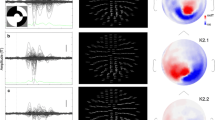Abstract
Empirical mode decomposition (EMD) has recently been introduced as a local and fully data-driven technique for the analysis of non-stationary time-series. It allows the frequency and amplitude of a time-series to be evaluated with excellent time resolution. In this article we consider the application of EMD to the analysis of neuronal activity in visual cortical area V4 of a macaque monkey performing a visual spatial attention task. We show that, by virtue of EMD, field potentials can be resolved into a sum of intrinsic components with different degrees of oscillatory content. Low-frequency components in single-trial recordings contribute to the average visual evoked potential (AVEP), whereas high-frequency components do not, but are identified as gamma-band (30–90 Hz) oscillations. The magnitude of time-varying gamma activity is shown to be enhanced when the monkey attends to a visual stimulus as compared to when it is not attending to the same stimulus. Comparison with Fourier analysis shows that EMD may offer better temporal and frequency resolution. These results support the idea that the magnitude of gamma activity reflects the modulation of V4 neurons by visual spatial attention. EMD, coupled with instantaneous frequency analysis, is demonstrated to be a useful technique for the analysis of neurobiological time-series.
Similar content being viewed by others
References
R Balocchi D Menicucci E Santarcangelo L Sebastiani A Gemignani B Ghelarducci M Varanini (2004) ArticleTitleDeriving the respiratory sinus arrhythmia from the heartbeat time-series using empirical mode decomposition Chaos Solitons Fractals 20 171–177 Occurrence Handle10.1016/S0960-0779(03)00441-7
JS Bendat AG Piersol (1986) Random data: analysis and measurement procedures Wiley New York
B Boashash (1992) ArticleTitleEstimating and interpreting the instantaneous frequency of a signal – Part I: fundamentals Proc IEEE 80 520–538 Occurrence Handle10.1109/5.135376
I Daubechies (1992) Ten lectures on wavelets SIAM Philadelphia
R Desimone J Duncan (1995) ArticleTitleNeural mechanisms of selective visual-attention Annu Rev Neurosci 18 193–222 Occurrence Handle10.1146/annurev.ne.18.030195.001205 Occurrence Handle1:CAS:528:DyaK2MXktl2ltrk%3D Occurrence Handle7605061
B Efron RJ Tibshirani (1993) An introduction to the boostrap Chapman & Hall/CRC London/Boca Raton
P Flandrin G Rilling P Goncalves (2004) ArticleTitleEmpirical mode decomposition as a filter bank IEEE Sig Proc Lett 11 IssueID2 112–114 Occurrence Handle10.1109/LSP.2003.821662
WJ Freeman (2004a) ArticleTitleOrigin, structure, and role of background EEG activity. Part 1. Analytic amplitude Clin Neurophysiol 115 IssueID9 2077–2088 Occurrence Handle10.1016/j.clinph.2004.02.029
WJ Freeman (2004b) ArticleTitleOrigin, structure, and role of background EEG activity. Part 2. Analytic phase Clin Neurophysiol 115 IssueID9 2089–2107 Occurrence Handle10.1016/j.clinph.2004.02.028
P Fries JH Reynolds AE Rorie R Desimone (2001) ArticleTitleModulation of oscillatory neuronal synchronization by selective visual attention Science 291 1560–1563 Occurrence Handle10.1126/science.1055465 Occurrence Handle1:CAS:528:DC%2BD3MXhsVeqt7Y%3D Occurrence Handle11222864
D Gabor (1946) ArticleTitleTheory of communication IEEE J Comm Eng 93 429–457
NE Huang Z Shen SR Long MC Wu HH Shih Q Zheng N-C Yen CC Tung HH Liu (1998a) ArticleTitleThe empirical mode decomposition and the Hilbert spectrum for nonlinear and nonstationary time-series analysis Proc R Soc Lond A 454 903–995
W Huang Z Shen NE Huang YC Fung (1998b) ArticleTitleEngineering analysis of biological variables: An example of blood pressure over 1 day Proc Nat Acad Sci USA 95 4816–4821 Occurrence Handle10.1073/pnas.95.9.4816 Occurrence Handle1:CAS:528:DyaK1cXivVyqtbk%3D
GM Jenkins DG Watts (1968) Spectral analysis and its applications Holden-Day San Francisco
HL Liang SL Bressler R Desimone P Fries (2005a) ArticleTitleEmpirical mode decomposition: a method for analyzing neural data Neurocomputing 65–66 801–807 Occurrence Handle10.1016/j.neucom.2004.10.077
Liang HL, Lin QH, Chen JDZ (2005b) Application of the empirical mode decomposition to the analysis of esophageal manometric data in gastroesophageal reflux disease. IEEE Trans Biomed Eng (in press)
HL Liang Z Lin RW McCallum (2000) ArticleTitleArtifact reduction in electrogastrogram based on the empirical mode decomposition method Med Biol Eng Comput 38 35–41 Occurrence Handle1:STN:280:DC%2BD3c3ovVWqtQ%3D%3D Occurrence Handle10829388
S Mallat (1998) A wavelet tour of signal processing Academic Press New York
AV Oppenheim RW Schafer (1989) Digital signal processing Prentice Hall Englewood Cliffs
DB Percival AT Walden (1993) Spectral analysis for physical applications Cambridge University Press New York
A Potamianos P Maragos (1994) ArticleTitleA comparison of the energy operator and Hilbert transform approach to signal and speech demodulation Sig Processing 37 95–120 Occurrence Handle10.1016/0165-1684(94)90169-4
Rilling G, Flandrin P, Goncalves P (2003) On empirical mode decomposition and its algorithms. In: IEEE-EURASIP workshop on nonlinear signal and image processing, Grado (I)
Z Wu NE Huang (2004) ArticleTitleA study of the characteristics of white noise using the empirical mode decomposition method Proc Roy Soc Lond A 460 1597–1611
Author information
Authors and Affiliations
Corresponding author
Rights and permissions
About this article
Cite this article
Liang, H., Bressler, S., Buffalo, E. et al. Empirical mode decomposition of field potentials from macaque V4 in visual spatial attention. Biol Cybern 92, 380–392 (2005). https://doi.org/10.1007/s00422-005-0566-y
Received:
Accepted:
Published:
Issue Date:
DOI: https://doi.org/10.1007/s00422-005-0566-y




